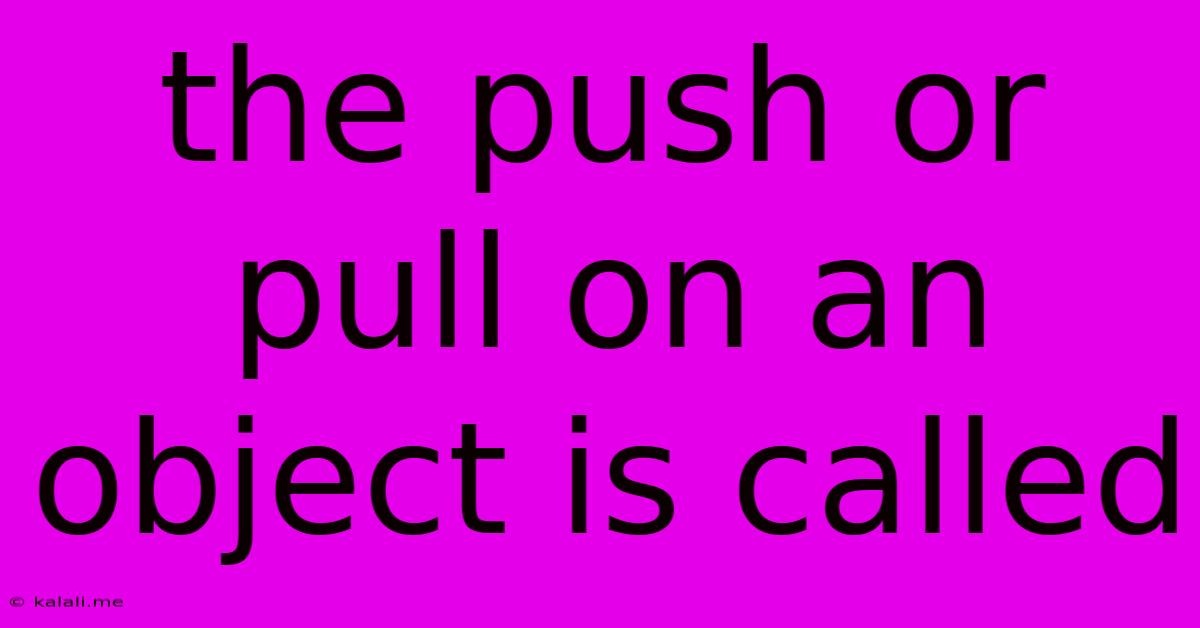The Push Or Pull On An Object Is Called
Kalali
Jun 15, 2025 · 3 min read

Table of Contents
The Push or Pull on an Object is Called Force: Understanding Forces and Motion
A push or pull on an object is called force. Understanding force is fundamental to comprehending how objects move and interact with each other. This article will explore the concept of force, its types, and its role in physics. Whether you're a student learning about Newton's Laws or a curious individual wanting to understand the world around you better, this guide will provide a comprehensive overview of this crucial physics concept.
Forces are a key concept in classical mechanics, and understanding them is crucial to grasping how things move, stop, or change direction. Forces can cause objects to accelerate, decelerate, or change shape. They're always part of an interaction between two objects.
Types of Forces
There are many different types of forces, each with its own unique characteristics. Some of the most common types include:
-
Contact Forces: These forces require physical contact between two objects. Examples include:
- Applied Force: A force applied directly to an object, such as pushing a box.
- Normal Force: The force exerted by a surface on an object in contact with it, preventing the object from falling through the surface.
- Frictional Force: A force that opposes motion between two surfaces in contact. This can be static friction (preventing motion) or kinetic friction (opposing motion).
- Tension Force: The force transmitted through a string, rope, cable or similar object when it is pulled tight by forces acting from opposite ends.
- Air Resistance: A force that opposes the motion of an object through the air.
-
Non-Contact Forces: These forces act on an object without direct physical contact. Examples include:
- Gravitational Force: The force of attraction between any two objects with mass. This is what keeps us grounded to Earth!
- Magnetic Force: The force exerted by magnets on magnetic materials or other magnets.
- Electrostatic Force: The force exerted by electrically charged objects on each other.
Understanding Force and Motion: Newton's Laws
Sir Isaac Newton's three laws of motion provide a framework for understanding how forces affect the motion of objects:
- Newton's First Law (Inertia): An object at rest stays at rest and an object in motion stays in motion with the same speed and in the same direction unless acted upon by an unbalanced force.
- Newton's Second Law (F=ma): The acceleration of an object is directly proportional to the net force acting on the object, is in the same direction as the net force, and is inversely proportional to the mass of the object (Force = mass x acceleration).
- Newton's Third Law (Action-Reaction): For every action, there is an equal and opposite reaction. This means that when one object exerts a force on a second object, the second object simultaneously exerts a force equal in magnitude and opposite in direction on the first object.
Measuring Force
Force is typically measured in Newtons (N) in the International System of Units (SI). One Newton is the force required to accelerate a one-kilogram mass at a rate of one meter per second squared.
Conclusion
In conclusion, the push or pull on an object is known as force. This fundamental concept is crucial to understanding how objects move and interact. By understanding the different types of forces and Newton's Laws of Motion, we can begin to predict and explain the behavior of objects in the physical world. This knowledge is essential across many fields, from engineering and physics to everyday life.
Latest Posts
Latest Posts
-
Identify The True And False Statements About Survey Research
Jun 15, 2025
-
Chromosomes Are Primarily Composed Of Dna And
Jun 15, 2025
-
What Are All Of The Factors Of 56
Jun 15, 2025
-
Which Of The Following Is A Characteristic
Jun 15, 2025
-
What Are All The Factors For 56
Jun 15, 2025
Related Post
Thank you for visiting our website which covers about The Push Or Pull On An Object Is Called . We hope the information provided has been useful to you. Feel free to contact us if you have any questions or need further assistance. See you next time and don't miss to bookmark.